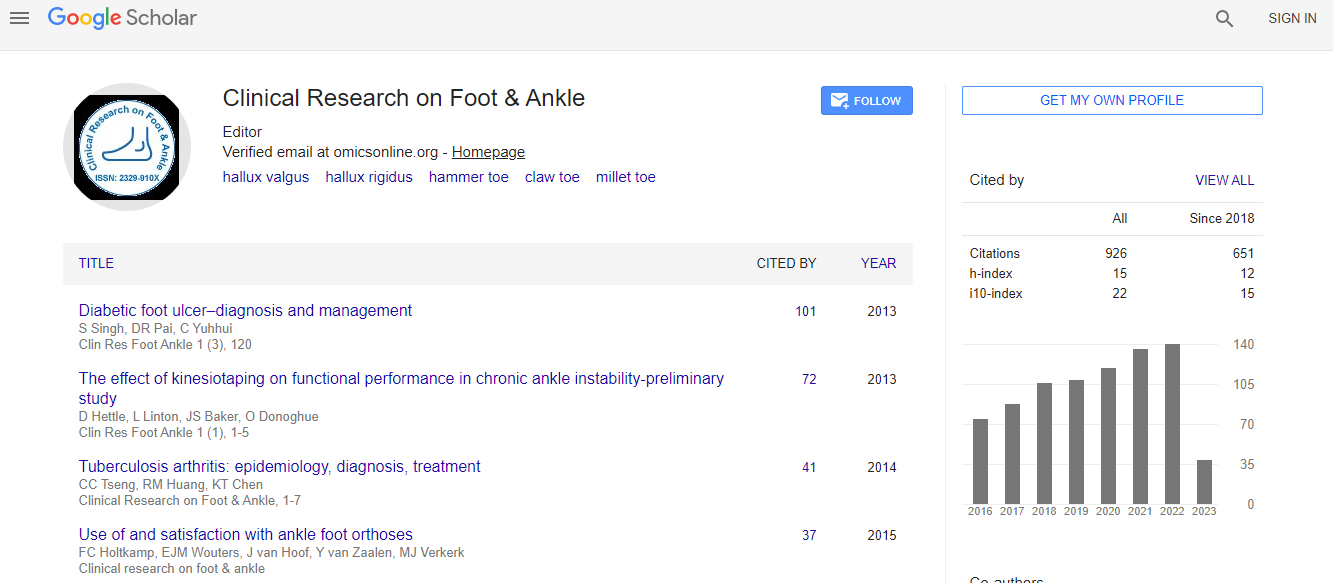Research Article
Implementation of the Ottawa Ankle Rules by Resident Orthopaedic Surgeons in an Emergency Department
| Ioannis Spanos*Vasilis Samdanis,Anastasios Chytas,Theodoros Beslikas,Ippokratis Hatzokos | ||
| Department of Podiatry, University of Sevilla, 2nd Orthopaedic Department, Aristotle University of Thessaloniki, Thessaloniki, Greece | ||
| Corresponding Author : | Ioannis Spanos Orthopaedic Surgeon, Research Fellow 2nd Orthopaedic Department of Aristotle University of Thesssaloniki Thessaloniki, Greece Tel: 00302310582290 E-mail: info@ortho-thessaloniki.gr |
|
| Received December 05, 2013; Accepted January 17, 2014; Published January 24, 2014 | ||
| Citation: Spanos I, Samdanis V, Chytas A, Beslikas T, Hatzokos I (2014) Implementation of the Ottawa Ankle Rules by Resident Orthopaedic Surgeons in an Emergency Department. Clin Res Foot Ankle 2:127. doi:10.4172/2329-910X.1000127 | ||
| Copyright: © 2014 Spanos I, et al. This is an open-access article distributed under the terms of the Creative Commons Attribution License, which permits unrestricted use, distribution, and reproduction in any medium, provided the original author and source are credited. | ||
Related article at Pubmed Pubmed  Scholar Google Scholar Google |
||
Abstract
Background: Routinely in an emergency department, radiographs are ordered for almost every patient with ankle injury, despite there are decision rules such as Ottawa Ankle Rules (OAR) to distinguish the patients who need them. The use of these rules is limited due to imperfect sensitivity and subjectivity of the method.
Objectives: To validate the accuracy of the OAR implemented by resident orthopaedic surgeons to rule out clinical significant ankle fractures in patients with acute ankle injuries.
Design: prospective cohort study.
Method: One hundred and twenty three patients presented with ankle injury in our emergency department during a two-month period (January 2012 to February 2012).One hundred and nineteen patients fulfilled the inclusion criteria for this study. Resident orthopaedic surgeons examined the patients and filled the data forms. All patients underwent blinded radiographic assessment by an orthopaedic surgeon and a radiologist.
Main outcome measures: sensitivity, specificity, potential reduction in radiographs needed.
Results: An ankle fracture was observed in thirty-four (28.6%) patients. In this group of patients, the OAR failed to predict two fractures (sensitivity 94.12%) and showed a relative low specificity (37.65%). The possible reduction in the radiographs needed was 28.6%.
Conclusions: This validation study of the OAR implemented by resident orthopaedic surgeons in a Greek setting produced similar results than those published previously in various other settings. The OAR for ankle injuries seem to be an accurate, objective, cost effective method to rule out ankle fractures.

 Spanish
Spanish  Chinese
Chinese  Russian
Russian  German
German  French
French  Japanese
Japanese  Portuguese
Portuguese  Hindi
Hindi 
